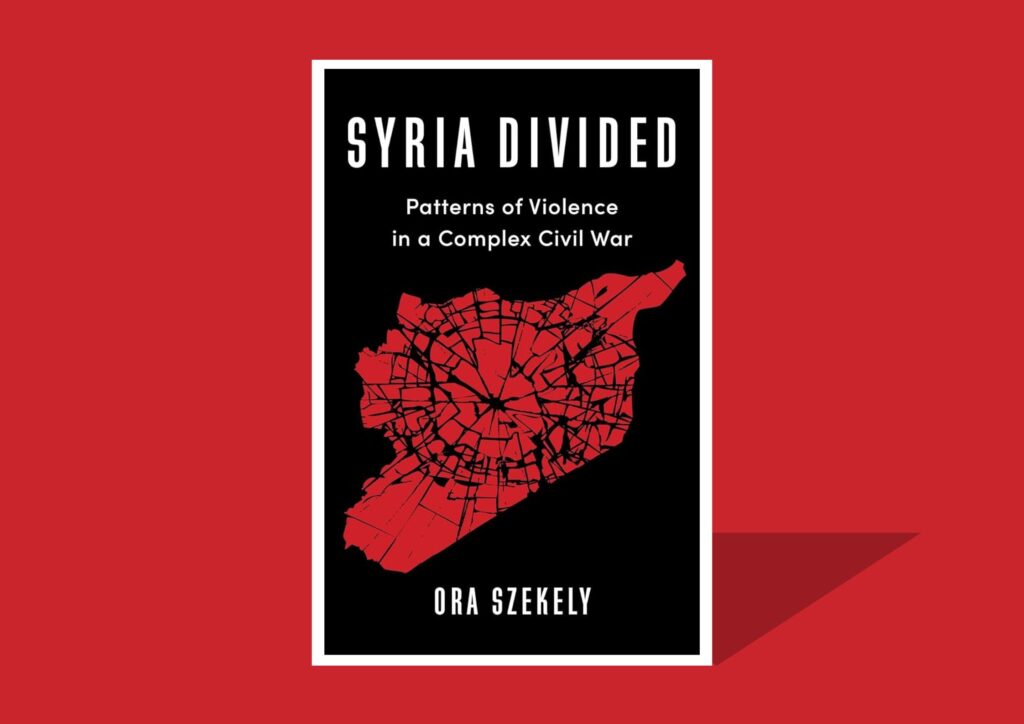Szekely’s Syria Divided: Patterns of Violence in a Complex Civil War offers a compelling analysis of the Syrian conflict through an interdisciplinary lens that emphasizes the performative and narrative dimensions of violence. Her core argument that the Syrian war is as much a battle over competing stories as it is over territorial control advances the scholarly understanding of modern conflicts by integrating political analysis, ethnography, media studies, and conflict data analysis. Within this framework, Szekely explores how acts of violence serve as communicative acts that reinforce, contest, or reshape narratives, both locally and globally.
The Syrian civil war, which began in 2011, exemplifies a multifaceted and prolonged conflict involving domestic factions, regional powers, and international actors. Much of the existing literature has focused on structural causes, ethnic and sectarian identities, or geopolitical interests. However, Szekely’s contribution is rooted in understanding the symbolic and performative aspects of violence, how violence functions not just strategically but also as storytelling. Her approach aligns with recent debates in conflict studies, which emphasize the importance of narratives, media, and digital propaganda.
Her work is especially relevant in the digital age, where social media platforms serve as stages for performative acts meant to influence perceptions and legitimize violence. As she notes, “the patterns of violence are embedded within the contest over meaning, with each actor deploying violence as a storytelling device”1. This perspective shifts focus from purely material explanations toward understanding the war’s symbolic dimensions, which are crucial for both conflict escalation and resolution.
The book is structured into four chapters (The Syrian Tragedy, What Are We Fighting For?, Patterns of Violence, The YouTube War ), each dissecting different facets of the Syrian conflict. The Introduction sets the stage by outlining her conceptual framework: that violence functions performatively within a broader narrative contest, shaped by multiple actors with divergent goals. The conclusion synthesizes her findings, emphasizing that understanding the Syrian war requires recognizing the performative and narrative dimensions of violence. She advocates for conflict resolution strategies that address these symbolic aspects, highlighting the potential of counter-narratives and digital de-escalation. The appendix details her methodological approach, combining ethnography, media analysis, and conflict data, providing transparency and rigor to her interdisciplinary framework.
Szekely’s combines qualitative ethnography interviews with Syrian exiles and defectors with content analysis of propaganda videos and social media posts. Her use of conflict event datasets (e.g., ACLED) enables temporal analysis of violence patterns in relation to narrative shifts. This mixed-method approach allows her to demonstrate convincingly that violence is not only strategic but also performative, embedded within a contest for meaning. She analyzes hundreds of videos, decoding symbols, framing devices, and staging techniques that serve to reinforce or challenge narratives. Her integration of qualitative and quantitative data aligns with contemporary trends that emphasize multimedia ethnography and conflict data triangulation.
The most significant contribution of Syria Divided lies in its reframing of violence as performative storytelling. Her ethnographic insights and media analyses exemplify how acts of violence are staged or documented with the intent of influencing perceptions and legitimacy. Her focus on digital propaganda and social media advances debates on hybrid warfare and informational conflict. The analysis of YouTube videos demonstrates how visual acts of violence are crafted as strategic messages either to intimidate opponents or to garner international sympathy. Recognizing that violence functions as a form of storytelling suggests that conflict resolution should include addressing symbolic grievances and countering misinformation. Her emphasis on digital literacy and counter-narratives complements emerging peacebuilding strategies that focus on narrative reconciliation.
While the book’s interdisciplinary approach is its strength, certain limitations should be acknowledged. First, the ethnographic sampling primarily includes exiled Syrians and online content, which might bias the analysis toward opposition narratives and digital activism, potentially underrepresenting perspectives from within Syria or pro-regime supporters. Incorporating remote ethnographic methods or satellite imagery could have offered a more balanced view. Second, the focus on narratives and performative violence risks underplaying structural drivers such as economic deprivation, state capacity, and resource competition. While Szekely acknowledges these factors, her primary emphasis remains on symbolic and discursive dimensions, which may oversimplify the complex causal drivers of conflict. Third, her analysis of social media content, though insightful, encounters challenges related to verification and authenticity. Videos are often staged or manipulated, raising questions about their representativeness and impact. A more detailed methodological reflection on content verification would enhance her claims. Finally, her policy recommendations, particularly the promotion of counter-narratives, require further elaboration. While she advocates digital de-escalation, specific strategies for implementing such initiatives in conflict zones remain underexplored.
Szekely’s work contributes significantly to the expanding literature on digital conflict, hybrid warfare, and the politics of storytelling. Her ethnographic approach also echoes calls for multimedia ethnography in conflict zones. Her focus on narratives extends debates on propaganda, social movements, and memory politics. By framing violence as a storytelling act, she bridges conflict analysis with cultural and communication studies, advancing theoretical debates and offering practical insights. Her work advocates for narrative reconciliation and digital literacy initiatives, emphasizing that peace efforts must address not only material grievances but also the symbolic and ideological underpinnings of violence. This perspective aligns with emerging policies emphasizing narrative-based peacebuilding, the need for context-sensitive and culturally informed strategies.
In sum, Ora Szekely’s Syria Divided offers a richly detailed, theoretically innovative, and methodologically rigorous account of the Syrian conflict. Her interdisciplinary approach, combining ethnography, media analysis, and conflict data, provides nuanced insights that are both academically valuable and practically relevant. While certain limitations, such as potential sampling bias and underemphasis on structural drivers, should be acknowledged, the core insights of her work advance understanding of modern conflict. Her emphasis on narratives and performative violence addresses the symbolic and communicative aspects of conflicts, offering valuable guidance for policymakers, peacebuilders, and researchers seeking to navigate the complexities of 21st-century civil wars.
References
[1] Szekely, Ora. Syria Divided: Patterns of Violence in a Complex Civil War. New York: Columbia University Press, 2023.




